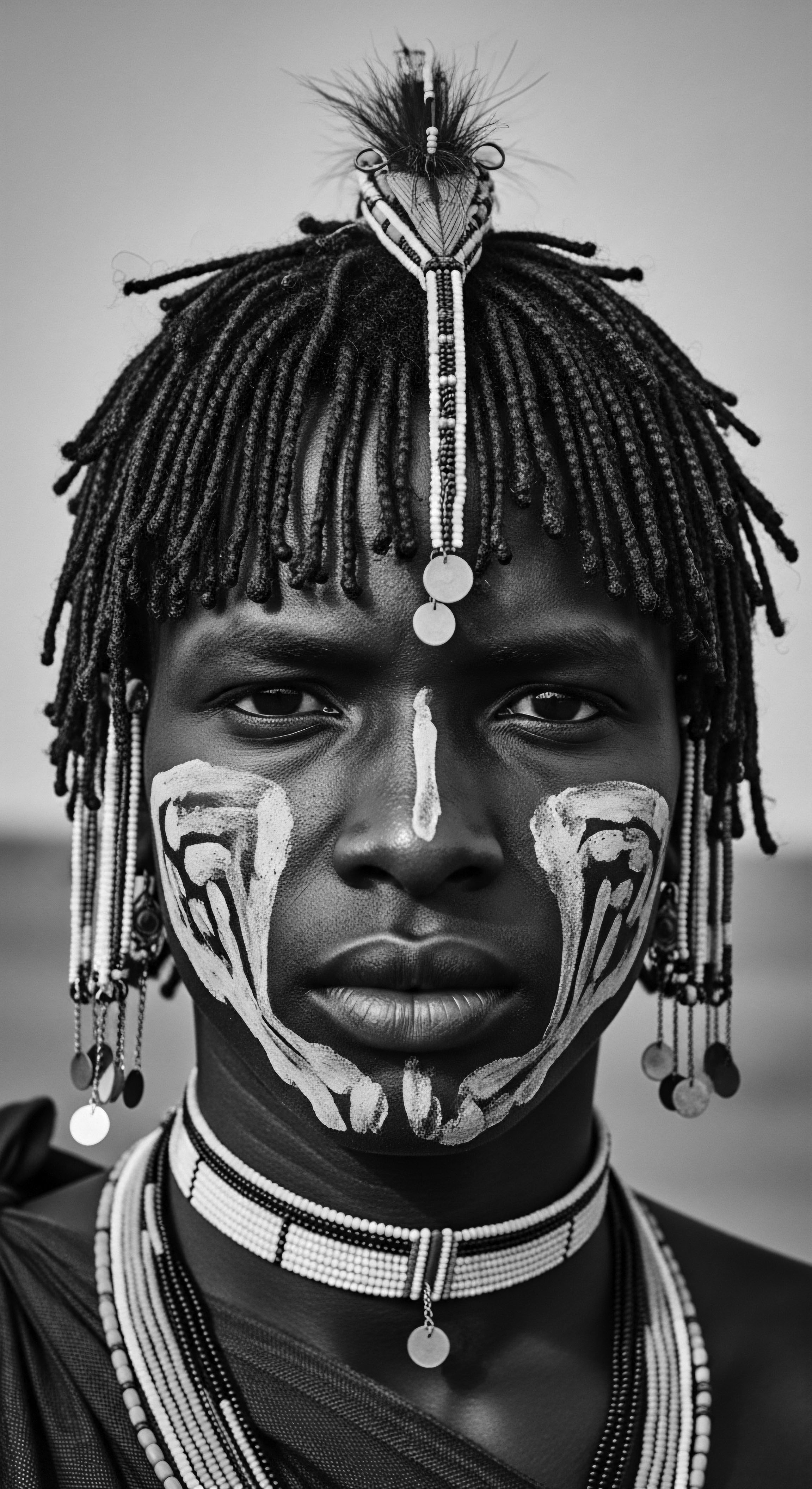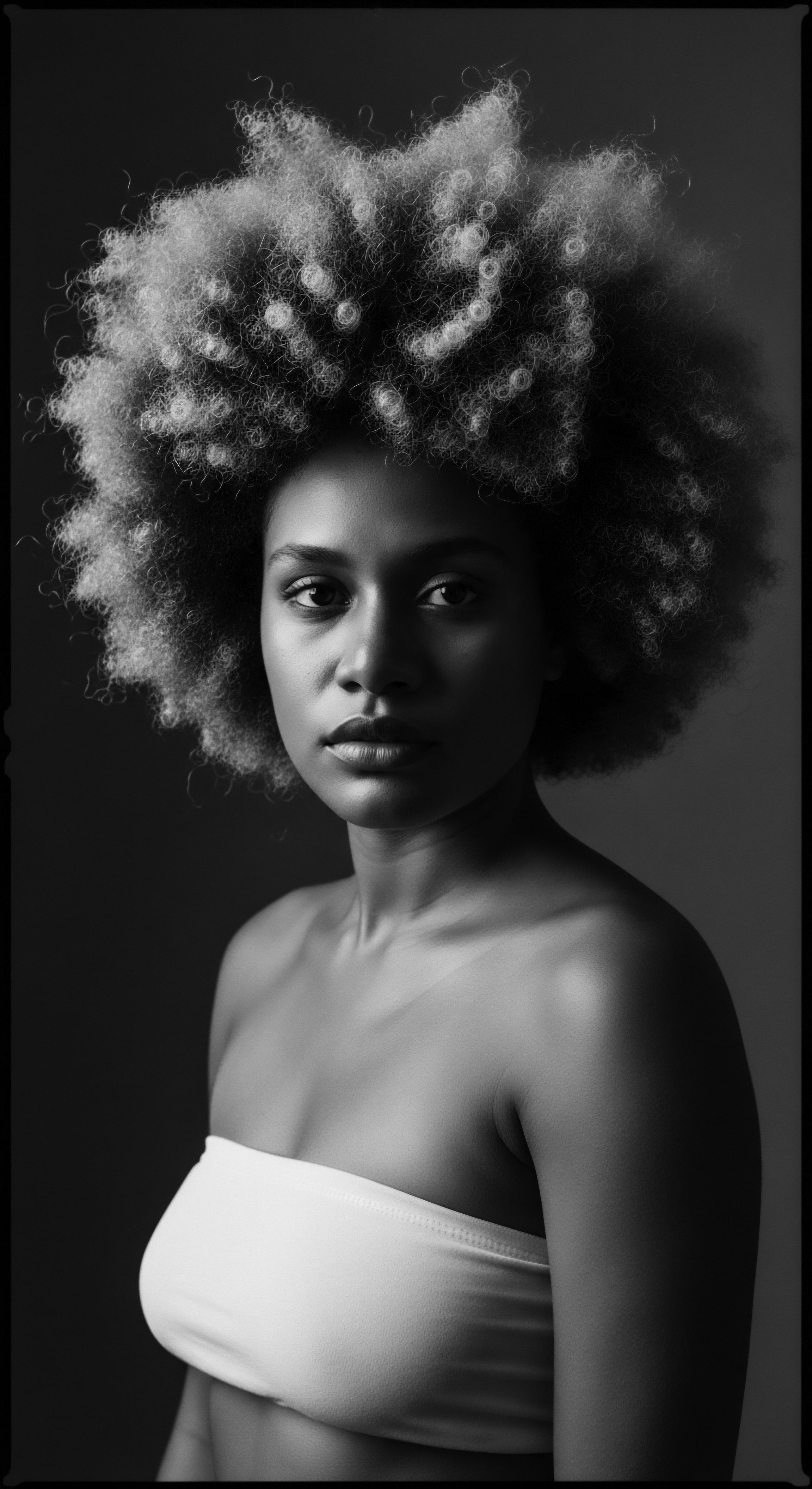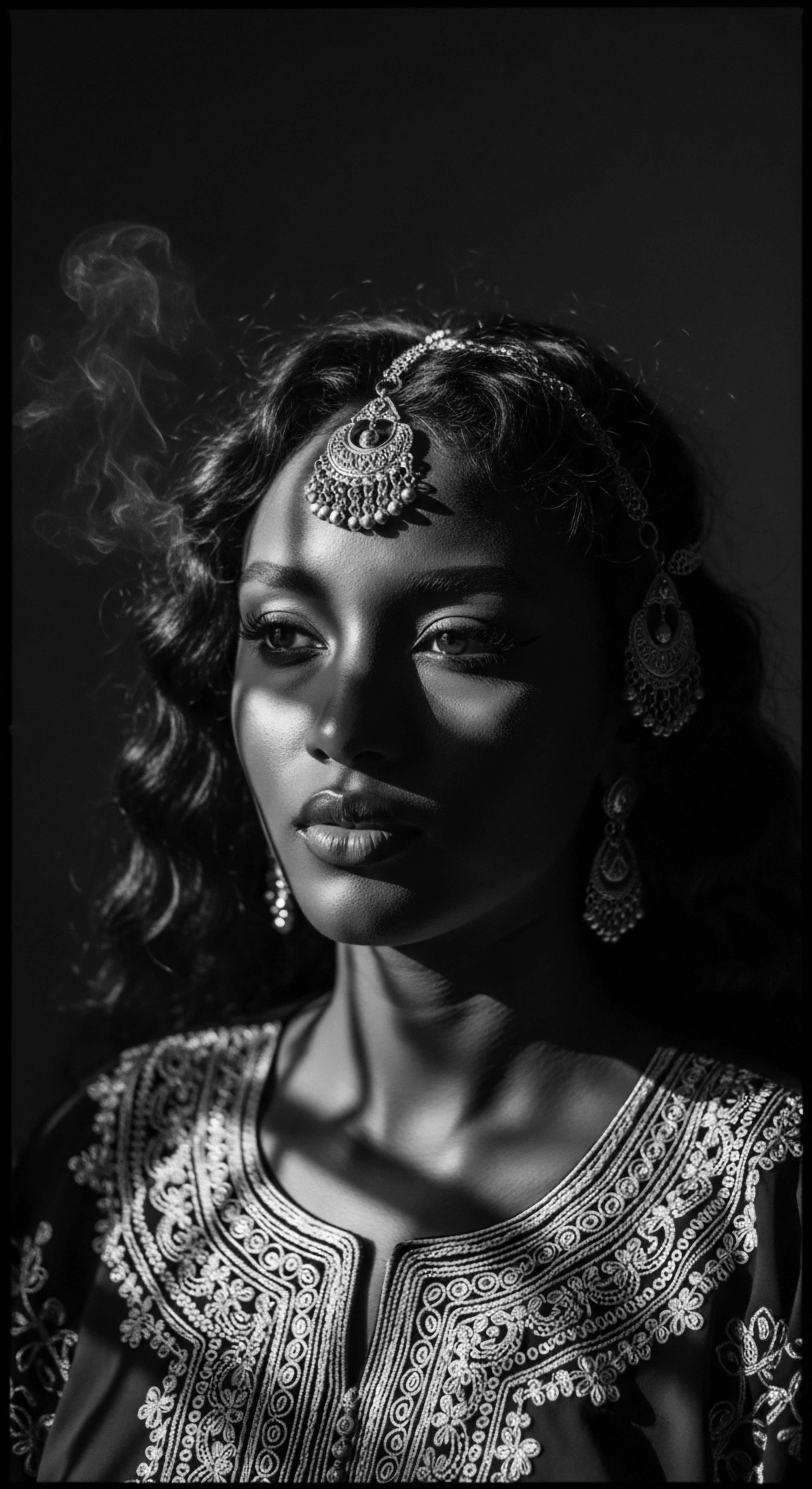
Fundamentals
The very notion of “Ancient Textured Hair” unveils a profound narrative, one etched deeply into the annals of human history and cultural continuity. To truly understand this concept, we look beyond a mere biological categorization; instead, we seek its inherent Meaning and historical significance , particularly as it relates to communities of Black and mixed-race heritage. At its simplest rendering, Ancient Textured Hair refers to hair exhibiting curl, coil, or wave patterns that have been recognized, cared for, and imbued with deep cultural value across civilizations stretching back millennia. This encompasses a broad spectrum of hair types, from loosely spiraled waves to tightly coiling strands, each possessing distinct structural characteristics inherited through generations.
Consider this understanding not as a static definition, but as a living archive, where each strand holds echoes of ancestral wisdom and resilience. The earliest indications of hair care, far from being purely aesthetic, served practical, social, and spiritual purposes. Archaeological discoveries from ancient societies, particularly in Africa, reveal sophisticated practices surrounding the grooming and adornment of textured hair, long before the advent of modern cosmetic industries. These practices were not isolated acts of vanity; they were integrated into the very rhythm of daily life, communal bonding, and expressions of identity.
Ancient Textured Hair represents a living lineage, holding ancestral wisdom and cultural significance in its very structure and traditional care.

Early Roots of Hair Recognition and Care
From the dawn of organized human societies, hair stood as a powerful visual cue, a profound communicator of social status, marital availability, age, and even spiritual beliefs. The intricate patterns woven into textured hair in ancient African civilizations, for example, functioned as a complex, unspoken language. These coiffures offered immediate information about an individual’s place within the community, their tribal affiliation, and their readiness for various life stages. The skill required to sculpt such intricate designs was often passed down through familial lines, reinforcing communal ties and preserving specialized knowledge.
The earliest known artistic renditions of braids, for instance, date back to 3500 BCE in Africa, with findings such as a rock painting in the Sahara desert depicting a woman with cornrows. This early evidence underscores the venerable nature of textured hair styling as an art form and a system of communication. The styles were functional, protecting hair from environmental elements, yet they concurrently carried layers of symbolic Meaning, a duality woven into the very fabric of ancient communal existence.
To delve deeper into the care practices of these early times, we observe a reliance on natural elements. Ancestral communities understood the properties of local botanicals, oils, and earth-derived ingredients, utilizing them to nourish and protect textured hair. This deep connection to nature for hair wellness reflects a holistic worldview, where the health of one’s hair was seen as intrinsically linked to overall well-being and a harmony with the natural world.
These foundational practices, often performed communally, established a tender thread of connection, linking individuals to their families, their tribes, and their spiritual heritage. The communal activity of braiding, for example, served as a cherished time for sharing stories, imparting wisdom, and strengthening familial bonds, a practice that continues to hold resonance in many Black and mixed-race communities today. This understanding provides a clear initial glimpse into what Ancient Textured Hair signifies ❉ a biological inheritance, a canvas for cultural expression, and a vessel of ancestral knowledge.

Intermediate
Advancing our understanding of Ancient Textured Hair requires a deeper exploration of its cultural manifestations and the sophisticated care rituals that sustained it through ages. The hair, in its diverse forms, was never merely a physical attribute; it held considerable spiritual weight and served as a tangible link to the divine for many ancient societies. The belief that the head, and thus the hair, was the closest part of the body to the heavens meant that hair became a channel for communication with ancestral spirits and deities. This spiritual reverence shaped many aspects of traditional hair care, from the choice of who could touch one’s hair to the specific times certain styles were worn.

Cultural Lexicons Etched in Hair
Across various African societies, specific hairstyles conveyed a wealth of information, operating as a distinct cultural lexicon. The complex patterns in braiding, for instance, often identified an individual’s ethnicity and affiliation . Consider the Fulani people of West Africa, renowned for their intricately braided cornrows, or the Himba Tribe of Southwest Africa, who traditionally adorned their thick braids with a mixture of clay and butter. These styles were not static; they transformed to mark different life stages, rites of passage, or significant communal events.
- Age and Gender ❉ Certain styles were exclusive to specific age groups or genders, indicating a transition from childhood to adulthood or signaling maturity within a community. Young women often wore elaborate braids during initiation ceremonies, marking their entry into adulthood.
- Marital Status ❉ The arrangement of braids could communicate whether a woman was married, widowed, or ready for marriage. In some South African contexts, box braids adorned with beads conveyed wealth and a readiness for marital union.
- Social Status and Wealth ❉ Elaborate coiffures, sometimes enhanced with precious materials, denoted higher social standing and prosperity. Ancient Egyptian elites, for instance, wore ornate wigs and braids bedecked with gold and jewels, symbolizing their wealth and connection to the divine.
- Spiritual and Religious Beliefs ❉ Hair could be associated with specific deities or serve as a form of spiritual protection. In Yoruba cosmology, hair stands as sacred, channeling spiritual energy, connecting individuals to their ancestors and deities.
The process of hair grooming itself was often a communal activity, fostering social cohesion and the transmission of cultural knowledge across generations. These intimate sessions, often among women, served as opportunities for storytelling, sharing wisdom, and reinforcing familial and community bonds. The care given to hair was a tangible expression of connection to one’s lineage.

Ancient Care Practices and Their Enduring Wisdom
Ancestral communities understood that hair health was intrinsically linked to its natural environment and the available resources. Ancient hair care rituals frequently utilized natural ingredients such as oils, butters, and herbs, which nurtured the scalp and strands.
| Ancient Ingredient/Practice Castor Oil (Ancient Egypt) |
| Traditional Use & Significance Used for moisturizing and strengthening hair, mixed with honey and herbs for masks, promoted growth and shine. |
| Modern Parallel/Understanding Recognized for its ricinoleic acid content, promoting circulation and moisturizing. Often used in hair growth serums and deep conditioners. |
| Ancient Ingredient/Practice Amla, Bhringraj, Coconut Oil (Ancient India – Ayurveda) |
| Traditional Use & Significance Nourished scalp, strengthened hair, prevented premature graying, often with warm oil scalp massages. |
| Modern Parallel/Understanding Common ingredients in natural hair products for their antioxidant, strengthening, and conditioning properties, validating ancestral wisdom. |
| Ancient Ingredient/Practice Shea Butter (Various African Tribes) |
| Traditional Use & Significance Applied for moisturizing and protecting hair from harsh environmental conditions, leaving hair soft and manageable. |
| Modern Parallel/Understanding A staple in textured hair care for its emollient properties, sealing in moisture and protecting strands. |
| Ancient Ingredient/Practice Yucca Root (Native American Tribes) |
| Traditional Use & Significance Crushed and mixed with water to create a natural, nourishing shampoo lather. |
| Modern Parallel/Understanding A natural saponin source, providing gentle cleansing without stripping natural oils, mirroring the modern desire for sulfate-free cleansers. |
| Ancient Ingredient/Practice These ancestral practices demonstrate an intuitive understanding of hair biology, providing a foundation for contemporary textured hair care. |
The profound Meaning of Ancient Textured Hair extends into its very biological make-up, revealing how its unique structure necessitated tailored care. These inherited hair properties, often presenting as curl, coil, or wave patterns, inherently responded to specific environmental conditions and care methods. For instance, the high lipid content found in African hair, a unique biological attribute, interacts with the hair’s keratin structure, influencing its texture and overall integrity.
Traditional practices often incorporated elements that would inherently support hair with such biological specificities, even if the precise scientific mechanisms were not yet articulated. This connection of elemental biology to generational care practices highlights a profound ancestral intelligence.
The communal act of hair braiding preserved not just styles, but also a deep understanding of hair’s purpose in society and spirit.
Hair wrapping, too, held a deep symbolic significance. Across the African diaspora, headwraps symbolized heritage, status, and spirituality, with different styles conveying specific meanings from West African Geles to East African Dhoop scarves. These coverings not only adorned but also protected hair from environmental aggressors, a practical aspect layered with cultural resonance. This ongoing tradition preserves a connection to ancestral knowledge and showcases a continuity of care and self-expression through generations.

Academic
The academic understanding of “Ancient Textured Hair” transcends anecdotal observations, grounding itself in a rigorous examination of its biological, anthropological, and sociological dimensions. It refers to the genetically inherited hair structures characterized by elliptical follicle shapes and varying degrees of curl or coil, which have been cultivated and culturally interpreted by human societies, particularly those of African, Indigenous, and diasporic heritage, over vast stretches of time. This scholarly approach delves into the inherent properties of textured hair and the intricate ways human ingenuity developed sophisticated systems of care, adornment, and communication around these unique characteristics, often predating formalized scientific inquiry.

Biological Architectures and Ancestral Interpretations
At its core, textured hair possesses a unique biological architecture. The cross-sectional shape of the hair follicle plays a significant role in determining curl pattern; Afro-textured hair, for instance, typically emerges from an elliptical follicle, creating a pronounced S-shaped or corkscrew curl as the hair strand grows. This contrasts with more circular follicles often associated with straight hair. The internal structure of the hair shaft, particularly the distribution and arrangement of keratin proteins and lipids, also contributes to the distinct properties of textured hair.
A critical biological insight, rigorously supported by research, indicates that African Hair Possesses a Higher Percentage of Internal Lipids Compared to Asian or Caucasian Hair. This elevated lipid content, as detailed in studies by Cruz et al. (2013), influences the structural arrangement of keratin dimers within the hair fiber.
Their findings suggest that these lipids intercalate, or interpose themselves, between keratin dimers, leading to a degree of disorganization in the typically ordered keratin structure. This disorganization is hypothesized to contribute to the characteristic texture of African hair, impacting its elasticity and resilience.
This scientific understanding offers a compelling explanation for the efficacy of traditional care practices that, for millennia, emphasized moisture retention and protective styling. Ancestral communities, without the benefit of microscopic analysis or chemical assays, developed intuitive systems that inherently worked with the biological realities of textured hair. The frequent use of natural butters, oils, and herbal concoctions in African and diasporic hair care, often passed down as treasured family traditions, served to supplement these inherent lipids and maintain the hair’s integrity.
The practice of daily or weekly application of rich, natural emollients, sometimes infused with herbs or animal fats as seen with the Basara Tribe’s use of Chebe, provided a robust defense against environmental stressors and breakage. This exemplifies a profound convergence of ancestral empirical knowledge with modern biological discovery.
The intricate dance between hair’s unique biology and ancient care practices underscores an ancestral intelligence long validated by contemporary science.

Hair as a Socio-Cultural Nexus
Beyond its biology, Ancient Textured Hair served as a complex socio-cultural nexus, reflecting power dynamics, spiritual beliefs, and systems of communication. In pre-colonial African societies, hair acted as a primary visual indicator of an individual’s identity, marital status, age, wealth, and tribal affiliation. This semiotic function of hair was not merely symbolic; it was deeply pragmatic.
The elaborate braiding techniques, some dating back thousands of years, were not only aesthetically pleasing but also encoded messages. A striking case study in the history of Black hair experiences involves the strategic use of cornrows during the Transatlantic Slave Trade. Enslaved African people, facing unimaginable oppression, ingeniously utilized intricate cornrow patterns to create hidden maps detailing escape routes from plantations. Rice seeds were even braided into hair for sustenance and cultural preservation, a testament to profound resilience and ingenious adaptation.
This singular example demonstrates how textured hair transcended a mere physical attribute to become a tool of survival, resistance, and continuity of heritage against forces seeking to erase identity. The hair, in this context, was a profound repository of collective will and a silent, yet powerful, means of defiance.
The forced shaving of heads upon arrival in the Americas during the slave trade represented a deliberate act of dehumanization and cultural eradication, aiming to sever the connection to ancestral practices and identity. Despite these brutal efforts, the resilience of Black communities ensured that hair traditions, often adapted and reinterpreted, persisted. The reclamation of natural hair styles, particularly during movements like the Civil Rights era with the rise of the Afro, represents a powerful continuum of this ancestral resistance and cultural pride.

The Epistemology of Ancient Textured Hair Knowledge
The knowledge systems surrounding Ancient Textured Hair were largely oral and embodied, passed through observation, practice, and intergenerational teaching. This contrasts with Western scientific methodologies that often prioritize written documentation and formalized experimentation. Yet, the longevity and efficacy of traditional hair care demonstrate a sophisticated understanding of hair properties. The traditional hair groomer, often a revered elder or skilled artisan, held a role akin to a community scientist, observing, experimenting, and refining practices through generations.
The tools employed in ancient hair care, while seemingly simple by modern standards, were expertly crafted for the specific needs of textured hair. Wooden or ivory combs were used for gentle detangling, preventing breakage in fragile strands. Primitive curling rods, heated carefully, or hairpins were utilized for styling. These tools, combined with a deep understanding of natural ingredients, formed a comprehensive system of hair wellness that prioritized preservation and health.
The academic investigation of Ancient Textured Hair, therefore, is not merely about cataloging historical styles. It is about understanding the complex interplay of biology, culture, and resistance that shaped the experiences of people with textured hair through history. It challenges contemporary beauty standards by centering a heritage of care and celebration that has long been overlooked or undervalued. It reveals how knowledge of hair was integrated into broader systems of spirituality, social order, and collective memory, reflecting a holistic approach to well-being that resonates strongly in modern discussions of self-care and cultural affirmation.
The study of Ancient Textured Hair illuminates how societies developed nuanced approaches to diverse hair types. This is not simply a historical curiosity; it provides a profound conceptual framework for appreciating the enduring legacy of Black and mixed-race hair experiences, underscoring the deep roots of identity and self-determination woven into every coil and curl.

Reflection on the Heritage of Ancient Textured Hair
As we reflect on the journey through the rich heritage of Ancient Textured Hair, it becomes clear that this concept represents far more than a historical footnote. It stands as a living testament to human ingenuity, cultural resilience, and the enduring power of identity. The echoes from the source, from the elemental biology of the strands to the foundational practices of ancient communities, resonate powerfully in our present moment. These ancestral rhythms of care, communal grooming, and symbolic adornment forged a tender thread connecting generations, offering a deep understanding of self and belonging.
This journey through time reveals that hair has always been a profound canvas for collective and personal storytelling. From the intricate patterns that conveyed status and spiritual connection in ancient African societies to the remarkable resilience of cornrows used as maps during periods of immense hardship, textured hair has consistently voiced stories of survival, artistry, and defiance. The care rituals, born of necessity and wisdom, nurtured not only the physical hair but also the spirit, weaving a protective shroud of cultural continuity.
The scientific validations of ancestral practices, revealing the unique biological properties of textured hair, serve to affirm the profound intelligence embedded in traditional knowledge. This bridge between ancient wisdom and contemporary understanding empowers us to appreciate the unbroken lineage of textured hair care. It invites a deeper respect for the practices passed down through families and communities, recognizing them as sophisticated, adaptable systems designed for optimal hair health and cultural expression.
Understanding Ancient Textured Hair is a profound act of honoring heritage, recognizing the resilience and artistry woven into every strand across generations.
Looking towards the future, the understanding of Ancient Textured Hair encourages us to continue the work of reclamation and celebration. It prompts us to consider how we can further integrate ancestral wisdom with modern insights, fostering a holistic approach to hair wellness that respects its biological realities and its profound cultural weight. This enduring legacy, vibrant and dynamic, ensures that the unbound helix of textured hair continues to tell its powerful story, inspiring pride, connection, and a timeless beauty rooted in heritage.

References
- Byrd, Ayana, and Lori L. Tharps. Hair Story ❉ Untangling the Roots of Black Hair in America. St. Martin’s Press, 2001.
- Cruz, Célia F. et al. “Keratins and lipids in ethnic hair.” International Journal of Cosmetic Science, vol. 35, no. 1, 2013, pp. 63-68.
- Douglas, Mary. Purity and Danger ❉ An Analysis of Concepts of Pollution and Taboo. Praeger, 1966.
- Farbman, A.I. The Hair Follicle ❉ A Comprehensive Guide to its Biology and Disease. Marcel Dekker, 2000.
- Gittens, Kimberly. “The History and Symbolism of Hair Wrapping Across the African Diaspora.” Ari Party Hair, 2025.
- hooks, bell. Bone Black ❉ Memories of Girlhood. Henry Holt and Company, 1996.
- Lake, O. Rastafari ❉ A Way of Life. Frontline Distribution, 1998.
- Montlouis, Stephane. The Hair, Its Essence, Its Spirit. CreateSpace Independent Publishing Platform, 2013.
- Okoro, Nkiru. African Hair ❉ History, Culture, and Beauty. Koinonia, 2016.
- Sieber, Roy, and Frank Herreman. Hair in African Art and Culture. Museum for African Art, 22 Jan. 2000.
